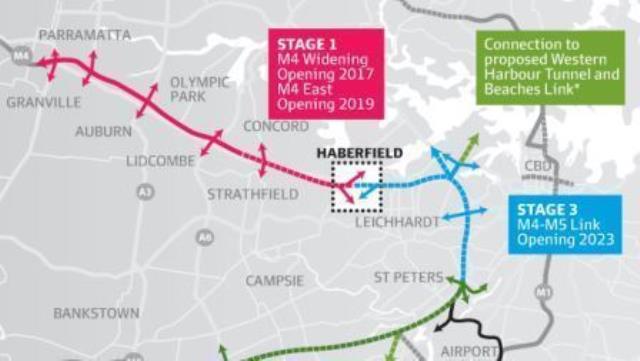The acrimonious battle over Australia's largest motorway may be a case study in how class conflict plays out across the 'post-industrial' metropolis. On one side, inner-urban gurus of 'liveability' and 'sustainability' envisage a string of high-amenity havens for professionals in the weightless knowledge economy. On the other, a more dispersed population of workers in the material world of freight production, delivery and storage need efficient connections between a range of scattered industries and transportation hubs.

In Sydney's case the flashpoint is Westconnex, a new motorway completing 33 kilometres of 'missing links' around eastern reaches of the Orbital Motorway Network, currently in early stages of construction. One section swerves over parts of the city's gentrified inner-south and inner-west. Resistance from a coalition of local residents, municipal politicians, academics, anti-mobility activists and inner-city based media has been vehement and implacable.
Advertisement
The 2012 New South Wales Long Term Transport Master Plan ("Long Term Plan"), amongst other documents, sets out the NSW Government's basic case for the project. "With Sydney growing, we need to fill the missing gaps", says the plan, "a fully connected motorway network will be the cornerstone of a free flowing road network." This sounds like a platitude but it expresses the fundamental point. Orbital motorways are otherwise known as ring-roads, loops and circumferential highways. The words 'orbital', 'ring', 'loop' and 'circumference' suggest a complete circle or circuit. Motorists can circulate faster and more freely around a whole metropolitan region without entangling themselves in the arterial road or street system. Intersections, traffic lights and cross-streets ('at-grade crossings') are replaced by overpasses and underpasses while interchange ramps facilitate entrances and exits.
Many of the world's leading cities would be dysfunctional without their orbitals. Imagine London with no M25, Boston with no Route 128, Washington DC with no Capital Beltway, Atlanta with no Perimeter, Vienna with no Ringstrasse or Paris with no Pèriphèrique.
The question is whether Sydney – which, as we are repeatedly told, claims 'global city' status – should have an orbital motorway or not. Though successful and indispensable, the existing 110 kilometre network is more semi-circle than circle. By the 1980's it was clear that earlier plans to build a radial motorway network centred on the CBD were inconsistent with Sydney's decentralized growth. The genesis of today's orbital lies in the then Department of Main Roads' 1987 report Roads 2000, which shifted the focus to a cross-suburban system.
Running laterally over south-western parts of metropolitan Sydney, M5 South West opened in 1992, followed by M2 Hills laterally north-west in 1993, M4 West laterally centre-west in 1997, and M7 Westlink vertically down the western edge in 2005. But there's no vertical M4-M5 link down the eastern side.
One of Westconnex's more strident critics, Mark Standen of Sydney University, claims it was pushed onto the Long Term Plan by "wealthy directors and shareholders of private toll road corporations … whose sole objective was to increase profits through the expansion of Sydney's toll road network". But the original proposals always included further motorways to close the loop, M4 East and M5 East. That these projects stalled had more to do with cynical politics than transportation analysis. The routes passed through gentrified inner-western electorates held by powerful figures of the Labor Government in office between 1995 and 2011. Plans for M4 East were exhibited in 2003 and quietly shelved.
By general consensus, the motorways bestow immense benefits on Sydney in travel time and vehicle operating cost savings, improved access, and reduced accidents. According to an estimate for Infrastructure Australia, their economic contribution to NSW as at 2008 was $22.7 billion. They were a factor in the city's post-globalisation rise to world stature. Only a few anti-mobility ideologues or eco-extremists would claim the M4, M5, M2 and M7 are a net cost and should be decommissioned. The case for completing the integrated system of which they were always envisaged to be constituent parts should be self-evident.
Advertisement
Anti-motorway activists cling to the delusion that public transport can handle future transport needs, especially light and metro rail. On basic population, traffic and freight projections alone, however, Sydney's road network faces escalating demands over coming decades. Reports like the Long Term Plan, the 2012 State Infrastructure Strategy ("SIS") and more recently the Westconnex Updated Strategic Business Case ("Updated Business Case") note that Sydney is expected to gain an extra 1.6 million people and 600,000 jobs by 2031 (though there's debate on whether this rate of growth is desirable).
Over that time, the total number of daily trips will increase by 31 per cent from 16 million to 21 million. Morning peak hour car trips are forecast to jump from 9 million in 2011 to 13 million in 2036. Overall, private car trips are expected to grow 27 per cent by 2032. Yet roads will continue to support the same 75 per cent of all weekday trips.
"In complex metropolitan areas with a multiplicity of journey origins and destinations", explains the SIS, "there is often no realistic alternative to the car for many journeys". Some 60 per cent of Sydney's jobs are dispersed outside of defined metropolitan centres, and of the six 'most constrained strategic corridors' identified in the Long Term Plan, 'Parramatta to the CBD via Strathfield' implicates the M4 and 'Liverpool to Sydney Airport' implicates the M5.